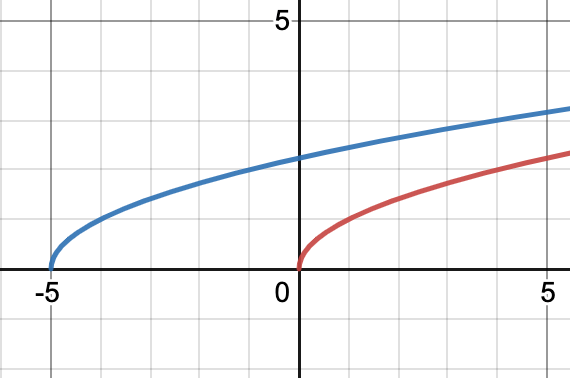Solve for b
D=(a+b)/2
b=2D-a
Write the equation of the line with slope = 2/3 and through (6,-5)
y=2/3x-9
Given that f(x)=sqrt(x-5)
Find
f(21)
f(21)=4
Identify the domain of the function below.
f(x)=sqrt(5-x)
x<=5
If f^-1(3)=7, what is f(7)?
f(7)=3
Describe the transformation of the red graph to the blue graph. 
Translation left 5 units
Solve for y
ax+by=c
y=(c-ax)/b
y=c/b-(ax)/b
Find the equation of the line through points (3, 7) and (6, 1)
y-7=-2(x-3)
y-1=-2(x-6)
y=-2x+13
Given f(x)=-x^2+3x-7
Find f(-2)
f(-2)=-17
Identify the domain and range of the function below.
f(x)=1/(2x+4)
x!=-2
y!=0
Given that f(x)=3x-7
Find f^-1(x)
f^-1(x)=(x+7)/3
Describe the transformations of the function below.
-|x-1|+6
Reflection over x-axis
Translation right 1 unit and up 6 units.
Solve for N
A=S(1-DN)
N=1/D-A/(SD
(S-A)/(SD)
Find the equation of the line perpendicular to line y = -5 and through the point (-1, 1)
x=-1
Given that f(x)=sqrt(x-2)-9 and g(x)=x^2+2
Find (f@g)(4)
(f@g)(4)=-5
Given that f(x)=1/(x-1) and g(x)=3x+7
Find the domain of (g@f)(x)
x!=1
Given that f(x)=sqrt(x-5),
Find the domain of f^-1(x)
D : x>=0
Given that f(x)=|x| . Write the function g(x) that reflects f(x) over the x-axis and translates it right 4 units.
g(x)=-|x-4|
Solve for F
C=5/9(F-32)
F=(9C)/5+32
Find the equation parallel to 4x-3y=14 and through the point (6, 8)
y-8=4/3(x-6)
y=4/3x
Given f(x)=3/x and g(x)=1/(2x+1)
Find (f@g)(x)
(f@g)(x)=6x+3
Given that f(x)=1/x and g(x)=sqrt(x+4)
Find the domain of f@g(x)
x> -4
Given that f(x)=2(x+4) and g(x)=(1-x)/3
Solve the equation (f@g^-1)(x)=2
x=4/3
Given that f(x)=x^2 g(x) is f(x) after it is reflected over the x-axis and translated to the left 7 units. What is the range of the g(x)?
R:y<=0
Solve for f
1/f=1/a+1/b
f=(ab)/(a+b)
Find the equation of the line perpendicular to 5x+2y=13 and through the point (15, 7)
y-7=2/5(x-15)
y=2/5x+1
Given the table below. Find (g@f)(6) 
(g@f)(6)=-7
Given that f(x)=x^2+4 and g(x)=1/(2x-3)
Find the domain of (g@f)(x)
x=RR
Given that f(x)=(x^2-1)/(x^2+1)
Find f^-1(x)
f^-1(x)=sqrt((x+1)/(1-x))
If f(x) has coordinates (-3, 25), (0, 0), (3, -35) and (6, 0). What would the coordinates of f(-3x) be?
(-3, 25) =>(1, 25)
(0, 0) =>(0, 0)
(3, -35) =>(-1, -35)
(6, 0) =>(-2,0)